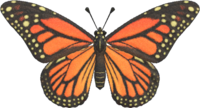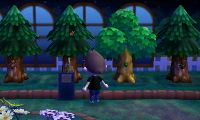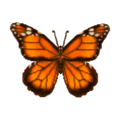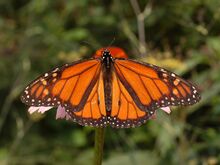Difference between revisions of "Monarch butterfly"
SuperHamster (talk | contribs) m (Text replacement - "\| image = (.*) NH Icon\.png" to "| image = $1 NH Icon.png | render = $1 NH.png") |
PanchamBro (talk | contribs) m (Text replacement - "{{Bugs}}" to "{{Navbox Bugs}}") |
||
| Line 193: | Line 193: | ||
{{Note list}} | {{Note list}} | ||
| − | {{Bugs}} | + | {{Navbox Bugs}} |
{{PC Bugs}} | {{PC Bugs}} | ||
[[Category:Butterflies]] | [[Category:Butterflies]] | ||
Revision as of 14:28, December 18, 2022
| ||||||||
 | ||||||||
| Real-world info | ||||||||
|---|---|---|---|---|---|---|---|---|
| Name: Danaus plexippus Family: Nymphalidae - Emperors, admirals, tortoiseshells and fritillaries | ||||||||
| Main appearances | ||||||||
|
| ||||||||
| Other appearances | ||||||||
Names in other languages
オオカバマダラ
大桦斑蝶 Monarque Mariposa monarca Farfalla monarca Монарх
왕나비 大樺斑蝶 Monarque Mariposa monarca Monarchfalter Monarchvlinder | ||||||||
The Monarch Butterfly (known as the Monarch prior to New Leaf)[nb 1] is a bug in the Animal Crossing series. The Monarch Butterfly first appeared in Animal Crossing: Wild World and has appeared in all subsequent games. Its scales are colored orange.
In the games that the Monarch Butterfly appears in, it is a common bug that the player can encounter, and can be found flying around flowers. In Animal Crossing: New Horizons, it can be caught during fall. It is the only butterfly to appear during fall and one is of four bugs (itself, the Cricket, the Bell Cricket, and the Migratory Locust) to be limited to fall.
Catch details
In Wild World
| Description | In a group, they can migrate up to 1,850 miles (3,000 km). |
|---|---|
| Time of year | Sep – Nov |
| Time of day | 8 AM – 5 PM |
| Peak times | Nov – Sep |
| Location | Flying near flowers |
| Bug size | Unknown |
| Rarity | Uncommon |
| Selling price | |
| Furniture size |
In City Folk
| Description | These are known for their ability to travel far -- in excess of 1,500 miles (2,400 km)! |
|---|---|
| Time of year | Sep – Nov |
| Time of day | Sep – Oct: 4 AM – 5 PM Nov: 8 AM – 5 PM |
| Peak times | Oct – Nov |
| Location | Flying near flowers |
| Bug size | Unknown |
| Rarity | Uncommon |
| Selling price | |
| Furniture size |
In New Leaf
| Time of year | Sep – Nov All year (Tortimer Island) |
|---|---|
| Time of day | Sep – Oct: 4 AM – 5 PM Nov: 8 AM – 5 PM Tortimer Island: 8 AM – 5 PM |
| Peak times | Sep: 8 AM – 4 PM Oct – Nov: 8 AM – 5 PM |
| Location | Flying near flowers (can be found on Tortimer Island) |
| Size | Unknown |
| Rarity | Common |
| Selling price | |
| Furniture size |
In Pocket Camp
| Availability | Not currently available
|
|---|---|
| Location | |
| Size | Unknown |
| Rarity | ★ |
| Selling price | |
| Version added | Unknown |
| Villager gift data | Tier: Unknown
Rewards: Unknown |
In New Horizons
| Time of year | North: Sep – Nov South: Mar – May |
|---|---|
| Time of day | 4 AM – 5 PM |
| Location | Flying near flowers |
| Weather | Any except rain |
| Spawn requirement | Appears from the start of the game |
| Selling prices | |
| Furniture size |
Donating to the museum
In Wild World
The Monarch Butterfly can be seen in flying around the upper right corner of the first bug room, occasionally perching on flowers.
In City Folk
After donation, it can be seen flying around on the upper tier of the insect exhibit.
In New Leaf

Upon being donated, the butterfly can be found in the room of the bug exhibit which has the light in the middle, resting on the tree which also is home to a Lantern Fly. The exhibit has this to say about the Monarch Butterfly:
In New Horizons
After donation, it can be seen flying around in the butterfly room.
Gallery
Real-world information
The monarch, sometimes known as the wanderer, is a milkweed butterfly with a wingspan ranging from 8.9 to 10.2 cm. Native to North America, the monarch can also be found in New Zealand, Australia, Portuguese archipelagos, and occasionally in Western Europe. Aside from their vivid orange coloration, the monarch is famous for its annual migration to and from North and South America, of which no single individual survives — the entire journey takes three to four generations of monarchs to complete. Due to their milkweed diet, the monarch is toxic, or at the very least distasteful to many would-be predators. The highest concentration of toxins can be found in the wings and abdomen of the monarch. The males have a brighter coloration than the females, and are slightly larger. Males also have two small black spots on their rear-wings [see picture], something that is not shared with females.
Names in other languages
| オオカバマダラ Ōkabamadara |
Monarch butterfly (lit. "birch milkweed butterfly") | |
| 왕나비 wangnabi |
Monarch butterfly | |
| 大桦斑蝶 dà huà bāndié |
Monarch butterfly (lit. "birch milkweed butterfly") | |
| 大樺斑蝶 Unknown |
||
| Монарх Monarkh |
Monarch | |
| Monarchvlinder | Monarch butterfly | |
| Monarchfalter | Monarch Butterfly | |
| Mariposa monarca | Monarch Butterfly | |
| Monarque | Monarch | |
| Farfalla monarca | Monarch butterfly | |
Notes
| Bugs | ||||||||||||||||||||||||||
|---|---|---|---|---|---|---|---|---|---|---|---|---|---|---|---|---|---|---|---|---|---|---|---|---|---|---|
| ||||||||||||||||||||||||||
| Pocket Camp bugs | ||||||||||||||||
|---|---|---|---|---|---|---|---|---|---|---|---|---|---|---|---|---|
| ||||||||||||||||







